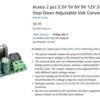Hey Guys,
I want to put a Marx or Lionel Stop-On-Signal Light on my layout. But, these don't come with light plus a bell sound, and I would like to add it. (I'm talking about a straight stop light, not a wig-wag with lights.)
Most of these things are pretty simple. They have two external screw-down posts to connect the power, and a third connector to run to a switch. I'm going to hook mine directly to the track , and use an insulated rail as the switch.
I don't want to rig up an actual bell to this, because they are too bulky and loud, and sound "fakey". So, I want to add an electrical unit that generates a train bell sound.
Searching online, I can't find any O gauge electrical unit that produces a bell sound. However, there are a couple of HO scale units that do this, with a pretty nice sound. Problem is, that these are powered by DC current.
I have a simple bridge rectifier, that is rated to convert my 16 volt AC track power to a DC current. (I used it successfully in the past to temporarily run my old Scout engine on DC.)
But here is my question. Assume I have hooked up the signal light to my track power and it works OK. Can I then run a separate set of feed wires off of the screw down posts, and then over to my bridge rectifier to convert it to DC power, and then out to the DC current bell sound unit?
I feel that this would probably work if this bridge rectifier and bell unit were connected straight to the track, but I'm not sure if problems would arise by having the power of the AC stop light and the feed wires out to the bridge rectifier share the same screw down posts under circumstances where I want both the light and the bell sound unit to operate at the same time.
Is there such as thing as "splash back" or "feed back" or "spill over" of some harmful current if I do this? Will the bell sound unit burn out? (I know that I'm going to have to check the DC output of the rectifier first to see how many DC volts are coming out of it, before I hook it to the bell unit, so make sure it doesn't exceed the bell unit's capacity. Or, . . . is it the amp output I'm supposed to check?)
Thanks for any advice.
Mannyrock








